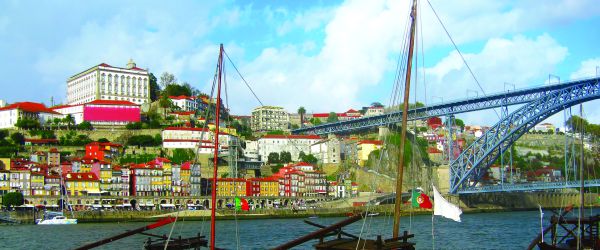Along with Portugal’s capital Lisbon, its second largest city Porto is the most frequented destination on any Douro river cruise and all river cruise lines which offer itineraries along the river stop there. The city is most famous for being the home of port and indeed, it’s how the famous beverage got its name. Although there’s plenty of opportunity to get immersed in the city’s viticultural pedigree, Porto offers visitors much in the way of cultural and architectural attractions, too.
Porto can trace its history to as far back as the fourth century when it was occupied by the Romans, who quickly saw its potential as a commercial port and set about developing it. It fell to the invading Moors in 711, though was reconquered in 868, the same year the country of Portugal was established, taking its name from the then-settlement of Portus Cale. 1387 saw the marriage of Philippa of Lancaster and John I of Portugal and also the birth of the oldest military alliance in the world, between England and Portugal. By the time of the 18th century, formal trading relations between the two countries had been established, which naturally involved a lot of port wine. The 19th century saw Napoleonic invasion, revolution and civil war, with the monarchy finally overthrown in 1919.
What not to miss
Any river cruise visit to Porto will no doubt include the option of a port-tasting excursion and you should always take up the opportunity. Even if you’re not a fan of port, it’s fascinating to learn about the history of the country’s biggest export and see how it’s made. What’s more, your visit will likely take you through the beautiful medieval waterfront area the Ribeira, which is a must-visit tourist area in itself. Aside from the port however, there are a number of key attractions which should be on anyone’s Porto to-do list.
Ponte D. Luis I
Top of the list for many travellers is this iconic bridge which dates back to 1886 and links Porto with neighbouring Gaia. The bridge carries the city’s metro line traffic but it’s also possible to walk across, albeit in single file, as the walkway’s so narrow. As you would expect, it’s a great way to view the river and the historic UNESCO World Heritage Site area and is even more of an attraction at night, when it is illuminated spectacularly.
Clerigos Tower
This is another lofty landmark you won’t be able to miss and one which offers some commanding views of the city from a different perspective. The tower is in fact the bell tower of the Clerigos Church, which was completed in 1750 and constructed in the Baroque style. The façade of the church is particularly beautiful and you should certainly take a look if you’re visiting the tower, even if you don’t have much time to explore the rest of the church.
Palacio da Bolsa
Also known as the Stock Market Palace, this building took almost 50 years to build, finally being completed in 1891 in the Neoclassic style. Originally a Franciscan convent, the original building was destroyed by fire in 1832, an event which led to the subsequent new structure. It’s a great building to explore, full of stunning craftsmanship and a guided tour will tell you everything you need to know about the building and its history.
Sao Francisco Church
Originally part of a convent, the church is the only feature which remains today. It’s truly spectacular baroque interior earned it UNESCO World Heritage Site status and the 18th century revamp it received used a staggering 200kg of gold. On your visit, expect to see some serious gilding, including some stunning altarpieces in all the chapels. One particular highlight is the Chapel of Nossa Senhora da Solddao, while the catacombs below are home to relics from the building’s long-past convent days.
Rail Station Sao Bento
Why would you want to visit the city’s railway station when you’ve travelled there by river cruise ship? Well, when the building’s a true architectural gem, it would be rude not to. Completed in 1916, the building is a great example of French Beaux-Arts architecture and most well-known for its pictorial tile display, which comprises around 20,000 tiles and tells the story of both Portugal and its transport history.
By Simon Brotherton
Google



